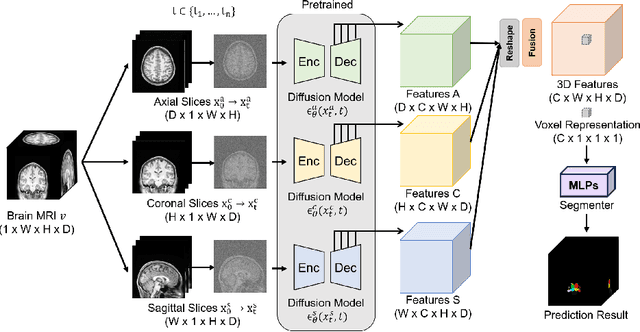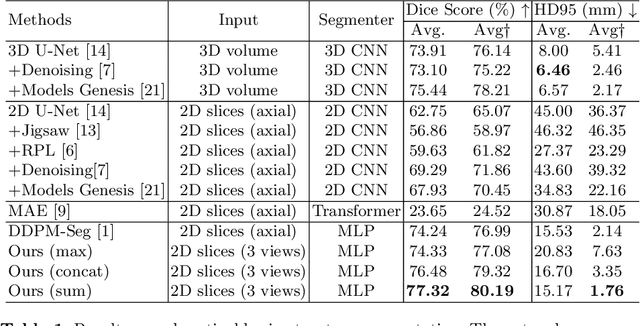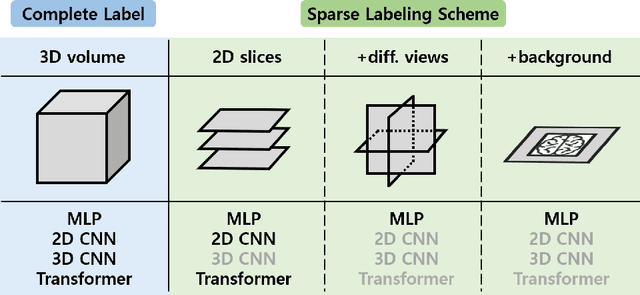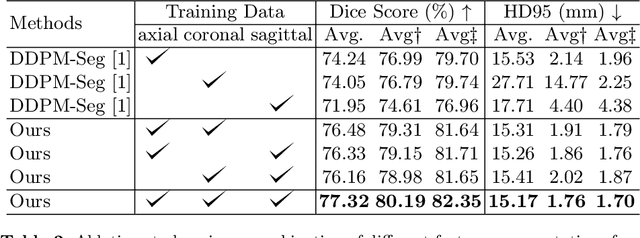Jinah Park
Volumetric Conditioning Module to Control Pretrained Diffusion Models for 3D Medical Images
Oct 29, 2024Abstract:Spatial control methods using additional modules on pretrained diffusion models have gained attention for enabling conditional generation in natural images. These methods guide the generation process with new conditions while leveraging the capabilities of large models. They could be beneficial as training strategies in the context of 3D medical imaging, where training a diffusion model from scratch is challenging due to high computational costs and data scarcity. However, the potential application of spatial control methods with additional modules to 3D medical images has not yet been explored. In this paper, we present a tailored spatial control method for 3D medical images with a novel lightweight module, Volumetric Conditioning Module (VCM). Our VCM employs an asymmetric U-Net architecture to effectively encode complex information from various levels of 3D conditions, providing detailed guidance in image synthesis. To examine the applicability of spatial control methods and the effectiveness of VCM for 3D medical data, we conduct experiments under single- and multimodal conditions scenarios across a wide range of dataset sizes, from extremely small datasets with 10 samples to large datasets with 500 samples. The experimental results show that the VCM is effective for conditional generation and efficient in terms of requiring less training data and computational resources. We further investigate the potential applications for our spatial control method through axial super-resolution for medical images. Our code is available at \url{https://github.com/Ahn-Ssu/VCM}
Two-Stage Approach for Brain MR Image Synthesis: 2D Image Synthesis and 3D Refinement
Oct 14, 2024Abstract:Despite significant advancements in automatic brain tumor segmentation methods, their performance is not guaranteed when certain MR sequences are missing. Addressing this issue, it is crucial to synthesize the missing MR images that reflect the unique characteristics of the absent modality with precise tumor representation. Typically, MRI synthesis methods generate partial images rather than full-sized volumes due to computational constraints. This limitation can lead to a lack of comprehensive 3D volumetric information and result in image artifacts during the merging process. In this paper, we propose a two-stage approach that first synthesizes MR images from 2D slices using a novel intensity encoding method and then refines the synthesized MRI. The proposed intensity encoding reduces artifacts when synthesizing MRI on a 2D slice basis. Then, the \textit{Refiner}, which leverages complete 3D volume information, further improves the quality of the synthesized images and enhances their applicability to segmentation methods. Experimental results demonstrate that the intensity encoding effectively minimizes artifacts in the synthesized MRI and improves perceptual quality. Furthermore, using the \textit{Refiner} on synthesized MRI significantly improves brain tumor segmentation results, highlighting the potential of our approach in practical applications.
Hand-object reconstruction via interaction-aware graph attention mechanism
Sep 26, 2024



Abstract:Estimating the poses of both a hand and an object has become an important area of research due to the growing need for advanced vision computing. The primary challenge involves understanding and reconstructing how hands and objects interact, such as contact and physical plausibility. Existing approaches often adopt a graph neural network to incorporate spatial information of hand and object meshes. However, these approaches have not fully exploited the potential of graphs without modification of edges within and between hand- and object-graphs. We propose a graph-based refinement method that incorporates an interaction-aware graph-attention mechanism to account for hand-object interactions. Using edges, we establish connections among closely correlated nodes, both within individual graphs and across different graphs. Experiments demonstrate the effectiveness of our proposed method with notable improvements in the realm of physical plausibility.
Label-Efficient 3D Brain Segmentation via Complementary 2D Diffusion Models with Orthogonal Views
Jul 17, 2024



Abstract:Deep learning-based segmentation techniques have shown remarkable performance in brain segmentation, yet their success hinges on the availability of extensive labeled training data. Acquiring such vast datasets, however, poses a significant challenge in many clinical applications. To address this issue, in this work, we propose a novel 3D brain segmentation approach using complementary 2D diffusion models. The core idea behind our approach is to first mine 2D features with semantic information extracted from the 2D diffusion models by taking orthogonal views as input, followed by fusing them into a 3D contextual feature representation. Then, we use these aggregated features to train multi-layer perceptrons to classify the segmentation labels. Our goal is to achieve reliable segmentation quality without requiring complete labels for each individual subject. Our experiments on training in brain subcortical structure segmentation with a dataset from only one subject demonstrate that our approach outperforms state-of-the-art self-supervised learning methods. Further experiments on the minimum requirement of annotation by sparse labeling yield promising results even with only nine slices and a labeled background region.
A Unified Framework for Synthesizing Multisequence Brain MRI via Hybrid Fusion
Jun 21, 2024Abstract:Multisequence Magnetic Resonance Imaging (MRI) provides a reliable diagnosis in clinical applications through complementary information within sequences. However, in practice, the absence of certain MR sequences is a common problem that can lead to inconsistent analysis results. In this work, we propose a novel unified framework for synthesizing multisequence MR images, called Hybrid Fusion GAN (HF-GAN). We introduce a hybrid fusion encoder designed to ensure the disentangled extraction of complementary and modality-specific information, along with a channel attention-based feature fusion module that integrates the features into a common latent space handling the complexity from combinations of accessible MR sequences. Common feature representations are transformed into a target latent space via the modality infuser to synthesize missing MR sequences. We have performed experiments on multisequence brain MRI datasets from healthy individuals and patients diagnosed with brain tumors. Experimental results show that our method outperforms state-of-the-art methods in both quantitative and qualitative comparisons. In addition, a detailed analysis of our framework demonstrates the superiority of our designed modules and their effectiveness for use in data imputation tasks.
Disentangled Multimodal Brain MR Image Translation via Transformer-based Modality Infuser
Feb 01, 2024Abstract:Multimodal Magnetic Resonance (MR) Imaging plays a crucial role in disease diagnosis due to its ability to provide complementary information by analyzing a relationship between multimodal images on the same subject. Acquiring all MR modalities, however, can be expensive, and, during a scanning session, certain MR images may be missed depending on the study protocol. The typical solution would be to synthesize the missing modalities from the acquired images such as using generative adversarial networks (GANs). Yet, GANs constructed with convolutional neural networks (CNNs) are likely to suffer from a lack of global relationships and mechanisms to condition the desired modality. To address this, in this work, we propose a transformer-based modality infuser designed to synthesize multimodal brain MR images. In our method, we extract modality-agnostic features from the encoder and then transform them into modality-specific features using the modality infuser. Furthermore, the modality infuser captures long-range relationships among all brain structures, leading to the generation of more realistic images. We carried out experiments on the BraTS 2018 dataset, translating between four MR modalities, and our experimental results demonstrate the superiority of our proposed method in terms of synthesis quality. In addition, we conducted experiments on a brain tumor segmentation task and different conditioning methods.
Hybrid-Fusion Transformer for Multisequence MRI
Nov 02, 2023Abstract:Medical segmentation has grown exponentially through the advent of a fully convolutional network (FCN), and we have now reached a turning point through the success of Transformer. However, the different characteristics of the modality have not been fully integrated into Transformer for medical segmentation. In this work, we propose the novel hybrid fusion Transformer (HFTrans) for multisequence MRI image segmentation. We take advantage of the differences among multimodal MRI sequences and utilize the Transformer layers to integrate the features extracted from each modality as well as the features of the early fused modalities. We validate the effectiveness of our hybrid-fusion method in three-dimensional (3D) medical segmentation. Experiments on two public datasets, BraTS2020 and MRBrainS18, show that the proposed method outperforms previous state-of-the-art methods on the task of brain tumor segmentation and brain structure segmentation.
Why is the winner the best?
Mar 30, 2023



Abstract:International benchmarking competitions have become fundamental for the comparative performance assessment of image analysis methods. However, little attention has been given to investigating what can be learnt from these competitions. Do they really generate scientific progress? What are common and successful participation strategies? What makes a solution superior to a competing method? To address this gap in the literature, we performed a multi-center study with all 80 competitions that were conducted in the scope of IEEE ISBI 2021 and MICCAI 2021. Statistical analyses performed based on comprehensive descriptions of the submitted algorithms linked to their rank as well as the underlying participation strategies revealed common characteristics of winning solutions. These typically include the use of multi-task learning (63%) and/or multi-stage pipelines (61%), and a focus on augmentation (100%), image preprocessing (97%), data curation (79%), and postprocessing (66%). The "typical" lead of a winning team is a computer scientist with a doctoral degree, five years of experience in biomedical image analysis, and four years of experience in deep learning. Two core general development strategies stood out for highly-ranked teams: the reflection of the metrics in the method design and the focus on analyzing and handling failure cases. According to the organizers, 43% of the winning algorithms exceeded the state of the art but only 11% completely solved the respective domain problem. The insights of our study could help researchers (1) improve algorithm development strategies when approaching new problems, and (2) focus on open research questions revealed by this work.
Joint Embedding of 2D and 3D Networks for Medical Image Anomaly Detection
Dec 23, 2022Abstract:Obtaining ground truth data in medical imaging has difficulties due to the fact that it requires a lot of annotating time from the experts in the field. Also, when trained with supervised learning, it detects only the cases included in the labels. In real practice, we want to also open to other possibilities than the named cases while examining the medical images. As a solution, the need for anomaly detection that can detect and localize abnormalities by learning the normal characteristics using only normal images is emerging. With medical image data, we can design either 2D or 3D networks of self-supervised learning for anomaly detection task. Although 3D networks, which learns 3D structures of the human body, show good performance in 3D medical image anomaly detection, they cannot be stacked in deeper layers due to memory problems. While 2D networks have advantage in feature detection, they lack 3D context information. In this paper, we develop a method for combining the strength of the 3D network and the strength of the 2D network through joint embedding. We also propose the pretask of self-supervised learning to make it possible for the networks to learn efficiently. Through the experiments, we show that the proposed method achieves better performance in both classification and segmentation tasks compared to the SoTA method.
WG-VITON: Wearing-Guide Virtual Try-On for Top and Bottom Clothes
May 10, 2022



Abstract:Studies of virtual try-on (VITON) have been shown their effectiveness in utilizing the generative neural network for virtually exploring fashion products, and some of recent researches of VITON attempted to synthesize human image wearing given multiple types of garments (e.g., top and bottom clothes). However, when replacing the top and bottom clothes of the target human, numerous wearing styles are possible with a certain combination of the clothes. In this paper, we address the problem of variation in wearing style when simultaneously replacing the top and bottom clothes of the model. We introduce Wearing-Guide VITON (i.e., WG-VITON) which utilizes an additional input binary mask to control the wearing styles of the generated image. Our experiments show that WG-VITON effectively generates an image of the model wearing given top and bottom clothes, and create complicated wearing styles such as partly tucking in the top to the bottom
 Add to Chrome
Add to Chrome Add to Firefox
Add to Firefox Add to Edge
Add to Edge